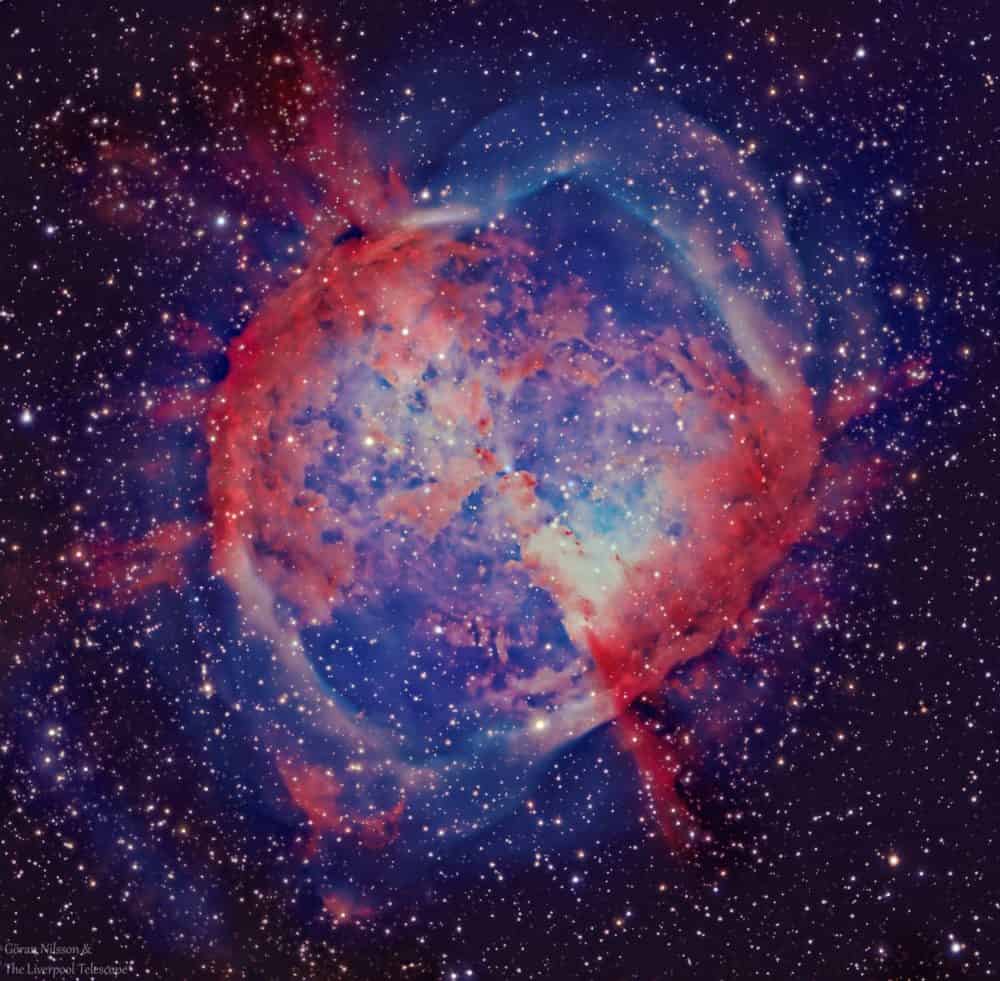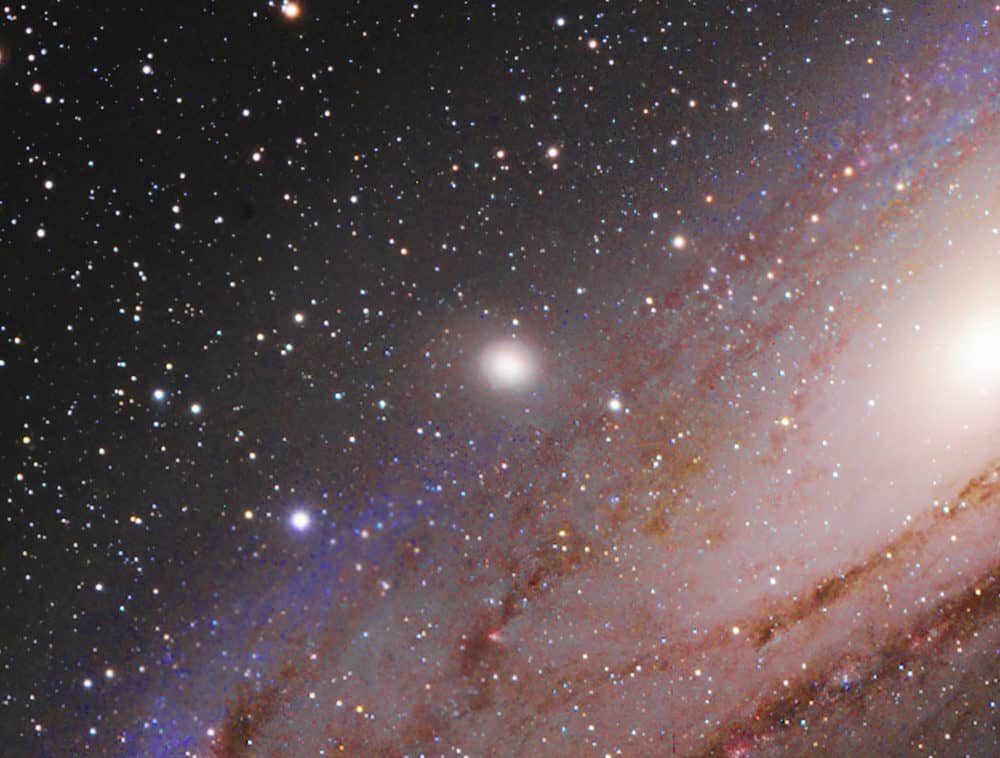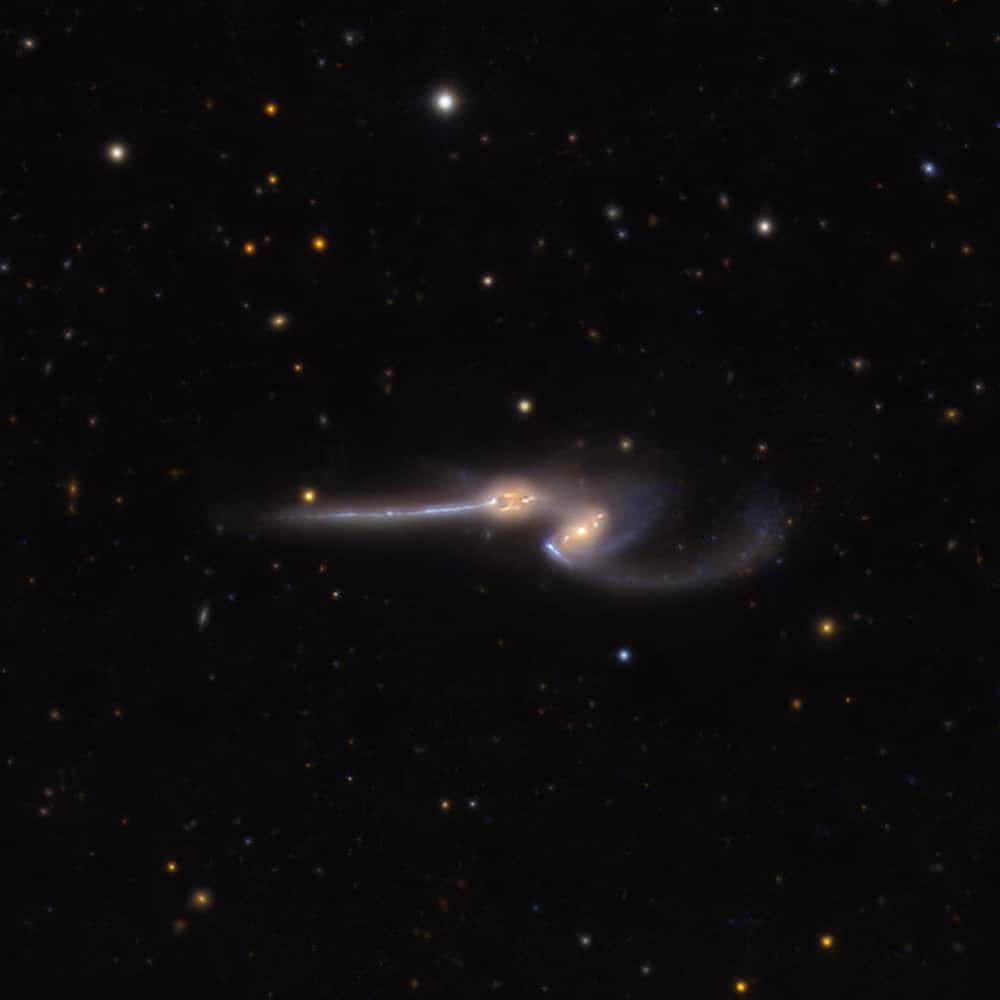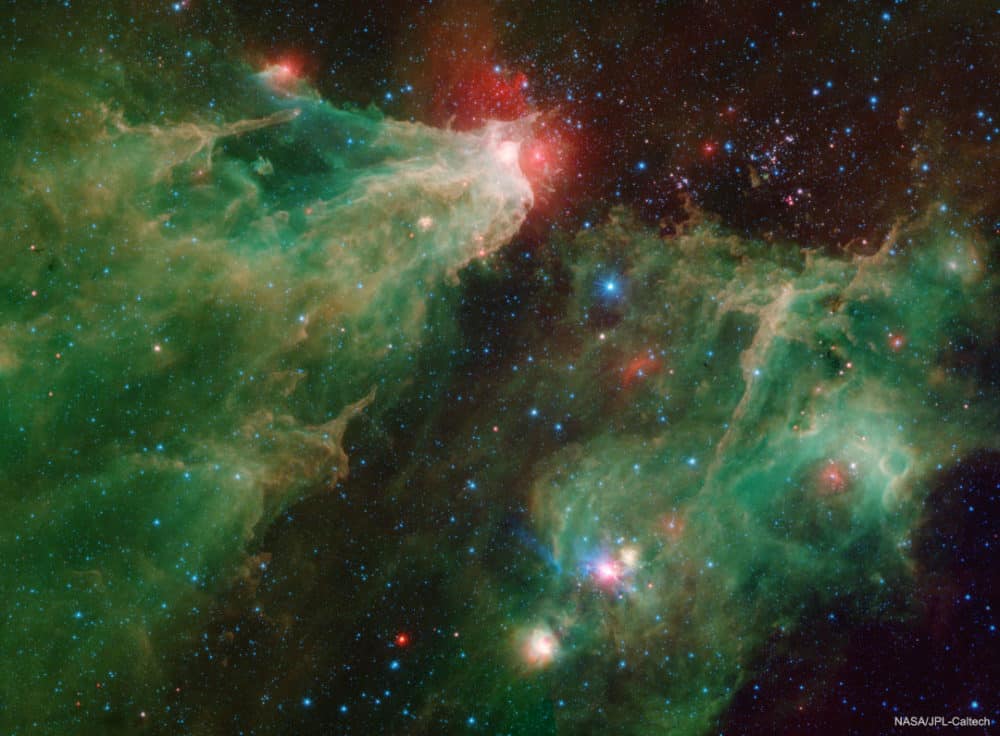Blog
The Dumbbell Nebula (also known as Apple Core Nebula, Messier 27, M 27, or NGC 6853) is a planetary nebula in the constellation Vulpecula, at a distance of about 1227 light-years. This object was the first planetary nebula to be discovered; by Charles Messier in 1764. At its brightness of visual magnitude 7.5 and its diameter of about 8 arcminutes, it is easily visible in binoculars, and a popular observing target in amateur telescopes. The Dumbbell Nebula appears to be shaped like a prolate spheroid and is viewed from our perspective along the plane of its equator. In 1992, Moreno-Corral et al. computed that its rate of expansion in the plane of the sky was no more than 2.3″ per century. From this, an upper limit to the age of 14,600 yr may be determined. In 1970, Bohuski, Smith, and Weedman found an expansion velocity of 31 km/s. Given its semi-minor axis radius of 1.01 ly, this implies that the kinematic age of the nebula is some 9,800 years.
Tom Harrell (born June 16, 1946) is an American jazz trumpeter, flugelhornist, composer, and arranger. Voted Trumpeter of the Year of 2018 byJazz Journalists Association, Harrell has won awards and grants throughout his career, including multiple Trumpeter of the Year awards from Down Beatmagazine, SESAC Jazz Award, BMI (Broadcast Music Incorporated) Composers Award, and Prix Oscar du Jazz. He received a Grammy Awardnomination for his big band album, Time’s Mirror.
Tom Harrell was born in Urbana, Illinois but moved to the San Francisco Bay Area at the age of five. He started playing trumpet at eight, and within five years he was playing gigs with local bands. In 1969 he graduated from Stanford University with a music composition degree and joined Stan Kenton‘s orchestra, touring and recording with them throughout 1969.
After leaving Kenton, Harrell played with Woody Herman‘s big band (1970–1971), Azteca (1972), the Horace Silver Quintet (1973–1977), with whom he made five albums, the Sam Jones-Tom Harrell Big Band, the Lee Konitz Nonet (1979–1981), George Russell, and the Mel Lewis Orchestra (1981). From 1983 to 1989 he was a pivotal member of the Phil Woods Quintet and made seven albums with the group. In addition, he recorded albums with Vince Guaraldi for whom he also did some arranging for the Peanuts television specials, Bill Evans, Dizzy Gillespie, Ronnie Cuber, Bob Brookmeyer, Lionel Hampton, Bob Berg, Cecil Payne, Bobby Shew, Philip Catherine, Ivan Paduart, Joe Lovano, Charlie Haden‘s Liberation Orchestra, Charles McPherson, David Sánchez, Sheila Jordan, Jane Monheit, the King’s Singers and Kathleen Battle among others. Harrell is featured on Bill Evans’ final studio recording, We Will Meet Again, which won a Grammy Award for Best Instrumental Jazz Performance, Group.
more...Eli “Lucky” Thompson (June 16, 1924 – July 30, 2005) was an American jazz tenor and soprano saxophonist. While John Coltrane usually receives the most credit for bringing the soprano saxophone out of obsolescence in the early 1960s, Thompson (along with Steve Lacy) embraced the instrument earlier than Coltrane. Thompson was born in Columbia, South Carolina, and moved to Detroit, Michigan, during his childhood. Thompson had to raise his siblings after his mother died, and he practiced saxophone fingerings on a broom handle before acquiring his first instrument. He joined Erskine Hawkins‘ band in 1942 upon graduating from high school.
After playing with the swing orchestras of Lionel Hampton, Don Redman, Billy Eckstine (alongside Dizzy Gillespie and Charlie Parker), Lucky Millinder, and Count Basie, he worked in rhythm and blues and then established a career in bebop and hard bop, working with Kenny Clarke, Miles Davis, Gillespie and Milt Jackson.
Ben Ratliff notes that Thompson “connected the swing era to the more cerebral and complex bebop style. His sophisticated, harmonically abstract approach to the tenor saxophone built off that of Don Byas and Coleman Hawkins; he played with beboppers, but resisted Charlie Parker’s pervasive influence.” He showed these capabilities as sideman on many albums recorded during the mid-1950s, such as Stan Kenton‘s Cuban Fire!, and those under his own name. He recorded with Parker (on two Los Angeles Dial Records sessions) and on Miles Davis’s hard bop Walkin’ session. Thompson recorded albums as leader for ABC Paramount and Prestige and as a sideman on records for Savoy Records with Jackson as leader.
Thompson was strongly critical of the music business, later describing promoters, music producers and record companies as “parasites” or “vultures”. This, in part, led him to move to Paris, where he lived and made several recordings between 1957 and 1962. During this time, he began playing soprano saxophone.
more...Josh Nelson my friend, next door neighbor and High School teacher is having his first inaugural Art Exhibit & Opening today & tomorrow at his new studio Funny Looking Horse. It is so great having him in our neighborhood!
more...Messier 32 (also known as M32 and NGC 221) is a dwarf “early-type” galaxy located about 2.65 million light-years from Earth, appearing in the constellation Andromeda. M32 is a satellite galaxy of the Andromeda Galaxy (M31) and was discovered by Guillaume Le Gentil in 1749. M32 measures 6.5 ± 0.2 thousand light-years in diameter at the widest point.
The galaxy is a prototype of the relatively rare, compact elliptical (cE) galaxy class. Half the stars concentrate within an effective radius of only 100 parsecs. Densities in the central stellar cusp increase steeply, exceeding 3×107 M⊙ pc−3 at the smallest radii resolved by HST, and the half-light radius of this central star cluster is around 6 parsec. Like more ordinary elliptical galaxies, M32 contains mostly older faint red and yellow stars with practically no dust or gas and consequently no current star formation. It does, however, show hints of star formation in the relatively recent past.
more...Harry Edward Nilsson III (June 15, 1941 – January 15, 1994), usually credited as Nilsson, was an American singer-songwriter who achieved the peak of his commercial success in the early 1970s. His work is characterized by pioneering vocal overdub experiments, returns to the Great American Songbook, and fusions of Caribbean sounds. A tenor with a 3½ octave range, Nilsson was one of the few major pop-rock recording artists of his era to achieve significant commercial success without ever performing major public concerts or undertaking regular tours. The craft of his songs and the defiant attitude he projected remains a touchstone for later generations of indie rock musicians.
Born in Brooklyn, Nilsson moved to Los Angeles as a teenager to escape his family’s poor financial situation. While working as a computer programmer at a bank, he grew interested in musical composition and close-harmony singing, and was successful in having some of his songs recorded by various artists such as the Monkees. In 1967, he debuted on RCA Victor with the LP Pandemonium Shadow Show, followed by a variety of releases that include a collaboration with Randy Newman (Nilsson Sings Newman, 1970) and the original children’s story The Point! (1971). His most commercially successful albums, Nilsson Schmilsson (1971) and Son of Schmilsson (1972), produced the international top 10 singles “Without You” (1971) and “Coconut” (1972). His other top 10 hit, “Everybody’s Talkin’” (1968), was a prominent song in the 1969 film Midnight Cowboy. A version of Nilsson’s “One“, released by Three Dog Night in 1969, also reached the U.S. top 10.
During a 1968 press conference, the Beatles were asked what their favorite American group was and answered “Nilsson”. He soon formed close friendships with John Lennon and Ringo Starr. In the 1970s, Nilsson and Lennon were members of the Hollywood Vampires drinking club, embroiling themselves in a number of widely publicized, alcohol-fueled incidents. At the same time, they produced one collaborative album, Pussy Cats (1974). After 1977, Nilsson left RCA, and his record output diminished. In response to Lennon’s 1980 murder, he took a hiatus from the music industry to campaign for gun control. For the rest of his life, he recorded only sporadically.
Nilsson created the first remix album (Aerial Pandemonium Ballet, 1971) and recorded the first mashup song (“You Can’t Do That“, 1967). He was voted No. 62 in Rolling Stone‘s 2015 list of the “100 Greatest Songwriters of All Time“, where he was described as “a pioneer of the Los Angeles studio sound, a crucial bridge between the baroque psychedelic pop of the late Sixties and the more personal singer-songwriter era of the Seventies”. The RIAA certified Nilsson Schmilsson and Son of Schmilsson as gold records, indicating over 500,000 units sold each. His honors include Grammy Awards for two of his recordings; Best Contemporary Vocal Performance, Male in 1970 for “Everybody’s Talkin'” and Best Pop Vocal Performance, Male in 1973 for “Without You”. In 1994, Nilsson died of a heart attack while in the midst of recording new material for a since-unreleased comeback album.
more...John Arthur “Jaki” Byard (June 15, 1922 – February 11, 1999) was an American jazz multi-instrumentalist, composer and arranger. Mainly a pianist, he also played tenor and alto saxophones, among several other instruments. He was known for his eclectic style, incorporating everything from ragtime and stride to free jazz.
Byard played with trumpeter Maynard Ferguson in the late 1950s and early 1960s, and was a member of bands led by bassist Charles Mingus for several years, including on several studio and concert recordings. The first of his recordings as a leader was in 1960, but, despite being praised by critics, his albums and performances did not gain him much wider attention. In his 60-year career, Byard recorded at least 35 albums as leader, and more than 50 as a sideman. Byard’s influence on the music comes from his combining of musical styles during performance, and his parallel career in teaching.
From 1969 Byard was heavily involved in jazz education: he began teaching at the New England Conservatory of Music and went on to work at several other music institutions, as well as having private students. He continued performing and recording, mainly in solo and small group settings, but he also led two big bands – one made up of some of his students, and the other of professional musicians. His death, from a single gunshot while in his home, remains an unsolved mystery.
Byard was born in Worcester, Massachusetts. At that time, his parents – John Sr and Geraldine Garr – were living at 47 Clayton Street. Both of his parents played musical instruments; his mother played the piano, as did his uncles and grandmother, the last playing in cinemas during the silent film era. He began piano lessons at the age of six, but they ended when his family was affected by the Great Depression. He was also given a trumpet that belonged to his father, and attempted to copy the popular players of the time, Roy Eldridge and Walter Fuller.[4] As a boy he often walked to Lake Quinsigamond to listen to bands performing there. He heard Benny Goodman, Lucky Millinder, Fats Waller, and Chick Webb, and listened to other bands of the era on the radio. “Those were the things that inspired me – I guess it stuck with me”, he commented decades later.
https://www.youtube.com/watch?v=OqR1wtZgMA0
more...Erroll Louis Garner (June 15, 1923 – January 2, 1977; some sources say b. 1921) was an American jazz pianist and composer known for his swing playing and ballads. His best-known composition, the ballad “Misty“, has become a jazz standard. Scott Yanow of Allmusic calls him “one of the most distinctive of all pianists” and a “brilliant virtuoso.” He received a star on the Hollywood Walk of Fame at 6363 Hollywood Blvd.
Garner was born with his twin brother Ernest in Pittsburgh, Pennsylvania on June 15, 1923, the youngest of six children in an African-American family. He attended George Westinghouse High School (as did fellow pianists Billy Strayhorn and Ahmad Jamal). Garner began playing piano at the age of three. His elder siblings were taught piano by Miss Bowman. From an early age, Erroll would sit down and play anything she had demonstrated, just like Miss Bowman, his eldest sister Martha said. Garner was self-taught and remained an “ear player” all his life, never learning to read music. At age seven, he began appearing on the radio station KDKA in Pittsburgh with a group called the Candy Kids. By age 11, he was playing on the Allegheny riverboats. At 14 in 1937, he joined local saxophonist Leroy Brown.
He played locally in the shadow of his older pianist brother Linton Garner.
Garner moved to New York City in 1944. He briefly worked with the bassist Slam Stewart, and though not a bebop musician per se, in 1947 played with Charlie Parker on the “Cool Blues” session. Although his admission to the Pittsburgh music union was initially refused because of his inability to read music, it relented in 1956 and made him an honorary member. Garner is credited with a superb memory of music. After attending a concert by the Russian classical pianist Emil Gilels, Garner returned to his apartment and was able to play a large portion of the performed music by recall.
https://www.youtube.com/watch?v=wmJ-mi9mAuo
more...So Africa
more...These two mighty galaxies are pulling each other apart. Known as The Mice because they have such long tails, each large spiral galaxy has actually passed through the other. Their long tails are drawn out by strong gravitational tides rather than collisions of their individual stars. Because the distances are so large, the cosmic interaction takes place in slow motion — over hundreds of millions of years. They will probably collide again and again over the next billion years until they coalesce to form a single galaxy. NGC 4676 lies about 300 million light-years away toward the constellation of Bernice’s Hair (Coma Berenices) and are likely membersof the Coma Cluster of Galaxies. Not often imaged in small telescopes, this wide field of view catches the faint tidal tails several hundred thousand light-years long.
more...Marcus Miller (born William Henry Marcus Miller Jr.; June 14, 1959) is an American jazz composer, producer and multi-instrumentalist, best known as a bass guitarist. He has worked with trumpeter Miles Davis, pianist Herbie Hancock, singer Luther Vandross, and saxophonist David Sanborn, among others. Miller was born in Brooklyn, New York City, in 1959 and raised in a musical family that included his father, William Miller (a church organist and choir director) and jazz pianist Wynton Kelly. He is classically trained as a clarinetist and also plays keyboards, saxophone and guitar. He began to work regularly in New York City, eventually playing bass and writing music for jazz flutist Bobbi Humphrey and keyboardist Lonnie Liston Smith. Miller soon became a session musician, appearing on over 500 albums by such artists as Michael Jackson, Beyoncé, Herbie Hancock, Mariah Carey, The Crusaders, Wayne Shorter, McCoy Tyner, Frank Sinatra, George Benson, Dr. John, Aretha Franklin, Elton John, Joe Walsh, Jean-Michel Jarre, Grover Washington Jr., Donald Fagen, Bill Withers, Bernard Wright, Kazumi Watanabe, Chaka Khan, LL Cool J and Flavio Sala.
Kenny Drew Jr. (June 14, 1958 – August 3, 2014) was an American jazz pianist. His music is known for its hard-swinging bluesy sound and large, two-handed rooty chords contrasting with fast runs. The son of jazz pianist Kenny Drew, he did not credit his father as an influence. His initial study was in classical music with his aunt and grandmother. In his teens he became interested in jazz and pop, but initially worked in funk bands. Later he went into jazz piano and in 1990 won the Great American Jazz Piano competition in Jacksonville, Florida. Drew continued to perform jazz, but he also performed some chamber music. His style has some similarities to his father’s, but is different enough to generally avoid comparison; he was considered the more eclectic of the two men.
Drew attended Iona College in New Rochelle, New York, for a period during 1977 to 1978. There, he became pianist for the Iona College Singers, an entertainment troop promoting the college’s name and goodwill among local high schools, retirement homes and the like in the Northeast region of the USA.
Drew cited Thelonious Monk as an influence and like Monk often recorded (and performed) solo.
Drew died at home in St. Petersburg, Florida, on August 3, 2014
https://www.youtube.com/watch?v=7j409BULnuQ
more...Flamenco Fridays featuring palo Bulerias.
The basic structure of bulerías
Bulerías, like other flamenco forms, has its own language. When we dance we are in conversation with the singer, the guitarist, and the palmeros. The structure offers a formula for clear communication, and it looks like this:
- Salida
- Marcaje(s)
- Paso de bulerías
- Llamada
- Patá (Patada)
- (Another Marcaje or Paso de Bulerías)
- Llamada
- Final
The Spitzer Space Telescope looked into this optically-dark star-forming region in four colors of infrared light. The Cave Nebula, cataloged as Sh2-155, is quite bright in infrared, revealing details not only of internal pillars of gas and dust, but of the illuminating star cluster too – all near the top of the image. The red glow around the Cave’s entrance is created by dust heated by bright young stars. To the right is Cepheus B, a star cluster that formed previously from the same cloud of gas and dust. Other interesting stars of Cepheus come to light in infrared as well, including those illuminating an even younger nebula toward the image bottom, and a runaway star pushing a bow shock, tinged in red near the image center. This region spans about 50 light years and lies about 2,500 light years toward the constellation of the King of Aethiopia (Cepheus).
more...
Adolphus Anthony Cheatham, better known as Doc Cheatham (June 13, 1905 – June 2, 1997), was a jazz trumpeter, singer, and bandleader. Doc Cheatham was born in Nashville, Tennessee of African, Cherokee and Choctaw heritage. He noted there was no jazz music there in his youth; like many in the United States he was introduced to the style by early recordings and touring groups at the end of the 1910s. He abandoned his family’s plans for him to be a pharmacist (although retaining the medically inspired nickname “Doc”) to play music, initially playing soprano and tenor saxophone in addition to trumpet in Nashville’s African American Vaudeville theater. Cheatham later toured in band accompanying blues singers on the Theater Owners Booking Association circuit.[1] His early jazz influences included Henry Busse and Johnny Dunn, but when he moved to Chicago in 1924 he heard King Oliver. Oliver’s playing was a revelation to Cheatham. Cheatham followed the jazz King around. Oliver gave young Cheatham a mute which Cheatham treasured and performed with for the rest of his career. A further revelation came the following year when Louis Armstrong returned to Chicago. Armstrong would be a lifelong influence on Cheatham.
Cheatham played in Albert Wynn’s band (and occasionally substituted for Armstrong at the Vendome Theater), and recorded on sax with Ma Rainey before moving to Philadelphia in 1927, where he worked with the bands of Bobby Lee and Wilbur de Paris before moving to New York City the following year. After a short stint with Chick Webb he left to tour Europe with Sam Wooding‘s band.
more...Attila Cornelius Zoller (June 13, 1927 – January 25, 1998) was a jazz guitarist born in Hungary. After World War II, he escaped the Soviet takeover of Hungary by fleeing through the mountains on foot into Austria. In 1959, he moved to the U.S., where he spent the rest of his life as a musician and teacher. Zoller was born in Visegrád, Hungary in 1927. As a child, he learned violin from his father, a professional violinist. While in school, he played flugelhorn and bass before choosing guitar. He dropped out of school and played in jazz clubs in Budapest while Russia occupied Hungary. He fled Hungary in 1948 as the Soviet Union was establishing communist military rule. He escaped on foot, carrying his guitar through the mountains into Austria. He settled in Vienna, became an Austrian citizen, and started a jazz group with accordionist Vera Auer.
In the 1950s, Zoller moved to Germany and played with German musicians Jutta Hipp and Hans Koller. When American jazz musicians passed through, such as Oscar Pettiford and Lee Konitz, they persuaded him to move to the United States. He moved to the U.S. after receiving a scholarship to the Lenox School of Jazz. One of his teachers was guitarist Jim Hall and his roommate was Ornette Coleman, who got him interested in free jazz.
From 1962–1965, Zoller performed in a group with flautist Herbie Mann, then Lee Konitz and Albert Mangelsdorff. Over the years, he played and recorded with Benny Goodman, Stan Getz, Red Norvo, Jimmy Raney, Herbie Hancock, Ron Carter, Shirley Scott, Cal Tjader, and Jimi Hendrix.
more...More Posts
- Gerry Mulligan Day
- Randy Weston Day
- Charlie Rouse Day
- Big Walter Horton Day
- World Fusion with Gao Hong & Issam Rafea
- Daily Roots with Evo Wiser
- Music for the Pandemic
- The Cosmos with NGC 4651
- Stan Levey Day
- Stanley Turrentine Day
- Billy Bland Day
- World Music with Brian Ó hEadhra
- Daily Roots with Tarrus Riley
- The Cosmos with the Manicouagan Crater
- Hugh Masekela Day
- Muddy Waters Day
- Cecil Gant Day
- World Music with Myrkur
- Daily Roots with Prince Far I
- Alpha Ousmane “Hama” Sankaré Memorial




